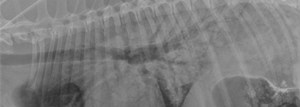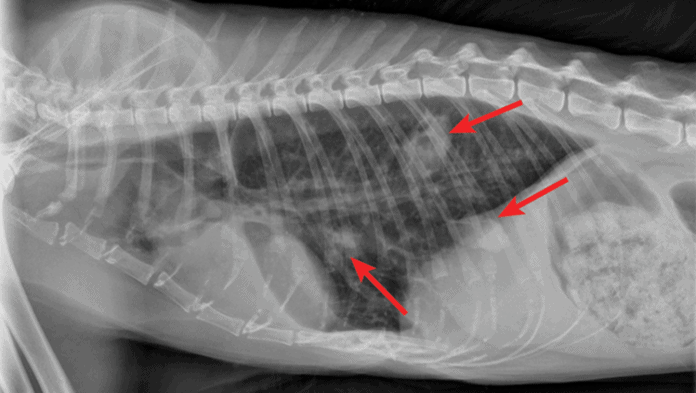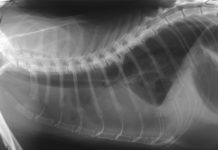Fluid in the lungs or pulmonary edema in cats is characterized by the accumulation of fluid in the lungs and is often linked with pneumonia. Even though there are a lot other possible causes of the condition. The normal lungs have fluid, which is moved from the lungs through the internal space of the body. This is an on-going process for the normal healthy function of the body. In case there is an added pressure in the lungs or some other primary conditions, this particular mechanism may be damaged and the fluid may start to buildup in the lungs.
Pulmonary Edema in Cats: What is this feline condition?

Fluid that fills the lungs or the surrounding pleural sac restricts the lungs from expanding fully and prevents the normal intake of oxygen. Asymptomatic swelling may not require treatment. However, clinical evidence of symptoms in the presence of swelling, especially if the blood vessels are leaking and causing the fluid build-up, requires immediate medical attention. In such cases, excessive fluid is accumulating in or around the lungs while too little of normal outflow is occurring.
The collection of fluid in or around the lungs of cats can refer to either pulmonary effusion or pulmonary edema. Healthy lungs normally have some fluid that move from the lungs to the internal space of the body and also help to prevent the lungs from adhering to the chest wall. However, if this process is disrupted due to added pressure or an underlying condition, fluid can back up into or around the lungs, causing impaired breathing. Both conditions are medical emergencies and should be treated immediately and aggressively since cats are not able to handle diminished lung function well.
Cats of all ages, genders, and breeds can experience these conditions, which can affect both the respiratory and cardiovascular systems. If left untreated, permanent damage can occur, but if addressed properly many cats experience positive results. The conditions have a variety of causes including congestive heart failure, cancer, infection, or from a traumatic injury such as electrocution or a blow to the head.
Causes of Pulmonary Edema
There are lots of possible causes of the pulmonary edema in cats. Some of the more common include the following:
- Blood clots
- Lung lobe torsion
- Leaky blood vessels
- Hernia
- Pulmonary emboli
- A near drowning
- An obstruction of the airway
- Toxin exposure
- Too little protein in the blood
- Traumatic injury
- Kidney disease
- Cancer
- Congestive heart failure
- Pneumonia
- Chylothorax
- Viral infection, as well as
- Anemia
Symptoms of Pulmonary Edema
The symptoms of pulmonary edema in cats include the following:
- Fever
- Chest pain
- Fainting
- Abdominal distention or swelling
- Inability to exercise
- Weakness
- Sluggishness
- Loss of appetite
- Extreme tiredness
- Bluish discoloration of the mucous membrane and the skin
- Increase in the respiratory rate
- Dry cough
- Wheezing
- Open-mouth breathing with a cracking noise, as well as
- Difficulty in breathing with rapid, deep breaths, especially when inhaling
Diagnosis of Pulmonary Edema
A diagnosis of pulmonary edema or pleural effusion is based on clinical evidence, medical history, and a physical examination such as the use of a stethoscope to detect heart murmurs or changes in heart rate, as well as to listen for normal movement of air in and out of the lungs.

- Tests that are typically conducted to determine a diagnosis as well as identify any underlying conditions are:
- CT angiography scan, which is not common but can be helpful in making a diagnosis
- Thoracentesis, also called pleural fluid analysis or chest tap, to find the cause of the fluid accumulation
- Blood and urine tests to look for hidden infections or systemic diseases
- Chest ultrasound to detect possible signs of fluid accumulating outside of the lungs and in the chest cavity, as well as
- Chest x-ray to detect possible signs of pleural fluid or pneumonia inside the lungs
Moreover, the underlying conditions that the veterinarian will be checking for are bronchitis, heartworm disease, heart disease (cardiomyopathy), and any upper airway obstructions.
If you observe your cat having any difficulty breathing at any time, an examination by your veterinarian is extremely urgent and necessary. The earlier the intervention the more positive the outcome. Waiting too long could lead to either permanent damage or death.
Treatment for Pulmonary Edema
The type of treatment will be dependent upon the severity of the medical condition. Additionally, oxygen may be used to help the animal to breathe, while certain fluids may be administered to aid in the flow of fluids within the cat’s body.
Furthermore, rest is recommended to assist in the cat’s recovery time. Also, diuretics have proven effective at reducing edema, as they work to force excess water and fluids out of the animal’s body.
Moreover, pay attention to your cat’s breathing rate if you able. Keeping track, perhaps even keeping a daily log, will allow you to better monitor how your cat is healing. If there are increases in the breathing rate and you notice other previously mentioned symptoms, call your veterinarian.









